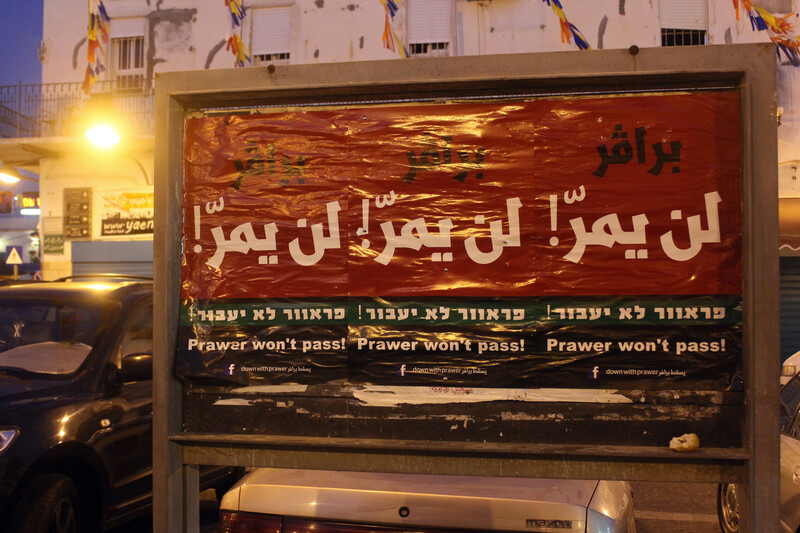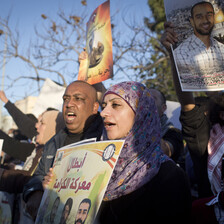The Electronic Intifada 7 September 2013

Posters against the Prawer Plan in Akka (Acre).
ActiveStillsThis summer has seen many activities by a youth-driven movement based in the part of Palestine that Zionist forces seized in 1948. Today, this area is generally called Israel. We prefer to call it the 1948 occupied territories.
The focus of this movement has been the Prawer Plan, a major offensive aimed at uprooting Palestinian Bedouins.
The statistics are overwhelming. The Prawer proposal aims to expropriate 800,000 dunams of Palestinian-owned land in the Naqab (Negev) desert (a dunam is equivalent to 1,000 square meters), displace up to 40,000 Bedouins and destroy 36 villages.
“Days of rage” were organized on 15 July and 1 August, with central protests held in the Naqab and in the north of historic Palestine, such as the towns of Sakhnin and Wadi Ara.
These protests have succeeded in drawing local and international attention to the threats posed by the Prawer proposal, and mobilized youth to take to the streets, including many who were not politicized. They also managed for the first time in a while to unite efforts across the fragmented sections of Palestinian society for one cause, as Palestinians in the 1948 territories, the West Bank and Gaza Strip all organized protests on the days of rage.
Great potential
Away from the virtual world, the mobilizing efforts on the ground have great potential. These include organizing campaigns, handing out out flyers in communities and towns, stenciling graffiti and the utilization of multimedia to produce creative, informative videos aimed at breaking the psychological fear barrier and the attitude that protesting doesn’t achieve anything. As one activist based in Jerusalem said, “My town hasn’t seen political graffiti since the second intifada.”
Palestinian political parties and politicians within the 1948 territories have inevitably tried to co-opt the protests for their own interests, and even tried to dictate when to disperse or end a protest, as was the case in the Naqab demonstration in July. However, there is a perception that these politicians and parties are finding themselves led by the youth instead of the other way around. And if the movement grows stronger then a power shift would emerge, where the official leadership would have little say in a popular resistance movement.
Stopping the Prawer plan was the ultimate demand of the nascent movement. This limits its potential to encompass broader issues such as opposition to “peace” negotiations with Israel, solidarity with political prisoners and the struggle against land theft and colonization in the whole of Palestine.
Despite the popular slogan, Prawer is not a “second Nakba” — a repeat of the ethnic cleansing conducted by Zionist forces in the 1940s. Rather, it is the consequence of systematic and entrenched Israeli colonialism, and should be treated as a symptom of such and not as an isolated problem.
Confined by citizenship
The struggle against Prawer tends to view the plan within a legal framework, as damning proof that Israel, the self-professed democracy, discriminates against its “Arab citizens.”
This stems from the fact that Palestinian politicians and most activists in the 1948 territories, who carry Israeli citizenship, remain confined by the boundaries of the citizenship discourse. This serves to normalize the situation of Palestinians with Israeli citizenship as if they are not under occupation.
Mainstream Palestinian politicians have not only accepted Israeli citizenship, but they have also strengthened this notion by adopting a liberal discourse that portrays the struggle of Palestinians as one for equality, better services and more political and civil rights. The national liberation concept is almost entirely absent from their agendas.
The relationship between Palestinians and Israel is not that of a citizen and a state; it is a relationship between a colonized and a colonizer. The scope of the rights of the colonized may vary; some colonized may have more rights than others but that does not mean that these Palestinians are not colonized.
Opposing the use of the citizenship discourse is not just a matter of semantics, dialectics and rhetoric. It has a long-reaching practical effect. It influences the entire frame of activism within Palestinian society.
There is a huge difference between fighting the state by using its laws and fighting outside the system, as Palestinians are not fighting to make the system more equitable. The fight is to destroy the entire system. It is a struggle for liberation; discrimination is just a syndrome, and not the biggest or the core problem.
The citizenship discourse is also dangerous in the way Palestinians from the 1948 territories perceive the struggle and their role in it. Many still believe that it’s possible to play within the laws of Israeli democracy. For example, they apply for permits before holding protests, or conduct training sessions on what rights Israel has granted Palestinians who are arrested.
Charade of democracy
To ignore the context of colonialism and use the basis of citizenship as the main weapon of our battle helps buttress Israel’s charade of democracy and citizenship, even if unwittingly.
Despite the perceived sense of enthusiasm among large sections of the youth involved in the burgeoning movement, there remain significant shortcomings. The movement has so far failed to capitalize on and sustain the momentum and transform it into a long-term and popular campaign inclusive of the different Palestinian causes.
What prevents this movement from developing into a sustainable one that will not be dismissed as merely a “spark” is that it operates within the basis of Newton’s third law: for every action there will be a reaction.
Movement-building requires more than online activism and occasional days of rage. It requires a clear vision and long-term strategic planning. It necessitates building alliances and networks from the bottom up through community work and reengagement with the people most affected by the policies being resisted. This explains why there was not a strong position on or outgrowth from the demolishing of al-Araqib village for the 53rd time following the first day of rage on 15 July.
Being stuck in the trap of reacting to events is not limited to the protests against Prawer. This has been a setback for short-lived Palestinian “uprisings” in the 1948 territories, as was evident in the Land Day strike in 1976, and what became to be known as the October uprising in 2000, when 13 Palestinians were murdered by Israeli occupation police.
Long-term vision
The lack of a long-term vision resulted in the swift quelling of these uprisings. Instead of expanding, the protests narrowed to seeking accountability from the Israeli state, and gave a false sense of satisfaction that partial goals were achieved.
Another feature of the movement against Prawer was the massive social media hype and euphoria surrounding the protests. While it is important to create publicity on such a crucial matter, it becomes nothing more than hype if it is limited to the alternate reality of social media. This can lead to detrimental factors such as the glorification of individual activists, who are portrayed as superstars instead of keeping low profiles and studying the faults and successes and determining ways to build a stronger movement.
The arrests of activists were also over-hyped; most of those arrested during such protests spent a very short time in prison, usually overnight, and despite the high cost to discourage people from protesting, their bails were covered. Furthermore, the emphasis on relative achievements such as the frontline role of women in protests — as if that was a new phenomenon — and the direct confrontations with the Israeli police tended to be exaggerated and out of proportion to what was still a fledgling movement.
These are by no means patronizing observations. Rather, they stem from the urgent need to recognize the similarities between other youth movements in Palestine that surfaced as the Arab uprisings spread in 2011, and that have either declined completely or reached a point of stagnation, as a result of a missing clear vision and almost a complete lack of on-the-ground mobilizing.
To ensure that the Prawer movement will not be an isolated spark in the larger context of Palestinian resistance, these actions should be used as a springboard to encompass a more inclusive activist movement for other Palestinian causes, and gain from the experiences of past initiatives such as the Ramallah-based 15 March movement in 2011. That initiative was botched due to similar factors as those we have already outlined, in addition to its attempt to replicate actions from other countries such as Egypt, while ignoring or failing to see that the context of Palestine differs drastically.
Learning process
The March 15 protests were organized both against the policies of the Palestinian Authority and the Israeli occupation in locations such as Qalandiya checkpoint. Later on, activists from the disbanded movement participated as individuals in protests in front of Ofer prison. Mistakes were made, opportunities waiting to be grabbed were wasted, a shared vision was missing, strategies and mobilization were elusive. But in the end, it’s all a learning process.
One model that could be built on is the expanding campaigns focusing on the right of return for Palestinian refugees. These campaigns not only seek to educate younger generations about and in ethnically cleansed villages in the 1948 territories, but also plan to transform symbolic actions into realities by moving into those villages full time.
Kick-started by youth with family connections to the Galilee village of Iqrit in 2011, the movement swelled to include youth camps that were set up in the ethnically cleansed villages of Kufr Baram, Ghabisiyya and Miar.
These initiatives carry with them a long-term vision and sustainable movement-building, which do not always find that mainstream media attention is the top priority, especially in the beginning stages. These are the efforts which will pave the way forward for other youth movements throughout Palestine.
Linah Alsaafin is a graduate of Birzeit University and a writer based in Ramallah, West Bank.
Budour Hassan is a Palestinian anarchist and law graduate based in occupied Jerusalem. She can be followed on Twitter: @Budour48.




